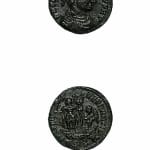Bronze Centenionalis of Emperor Constans, 348 CE - 358 CE
Bronze
C.7598
Further images
Obverse: DN CONSTANS PF AVG; Diademed Bust of the Emperor Facing Righ Reverse: FEL TEMP REPARATIO; Constans Standing Left on Galley, Holding a Phoenix Perched on a Globe and a...
Obverse: DN CONSTANS PF AVG; Diademed Bust of the Emperor Facing Righ
Reverse: FEL TEMP REPARATIO; Constans Standing Left on Galley, Holding a Phoenix Perched on a Globe and a Chi-Rho Banner, Victory Seated in Stern Steering the Shi
The fourth or fifth son of Constantine the Great, Constans was bestowed the title Caesar by his father in 333. When Constantine died in 337, Constans and his two brothers, Constantius II and Constantine II, each adopted the title of Augustus and divided the empire among themselves. Constans took control of Italy, Africa, and Illyricum (the northwestern Balkans). In 340 Constantine II—ruler of Spain, Gaul, and Britain—invaded northern Italy but was defeated and killed by Constans' army at Aquileia. This victory gave Constans control over the entire western half of the empire. He defended his realm successfully against the Franks in 341 and two years later visited Britain. In 350, however, he was overthrown and killed in Gaul by the usurper Magnus Magnentius. Overall Constans is remembered as an ardent orthodox Christian and vigorous opponent of paganism.
How many hands have touched a coin in your pocket or purse? What eras and lands have the coin traversed on its journey into our possession? As we reach into our pockets to pull out some change, we rarely hesitate to think of who might have touched the coin before us, or where the coin will venture to after it leaves our hands. More than money, coins are a symbol of the state that struck them, of a specific time and location, whether contemporary currencies or artifacts of a long forgotten empire. This stunning hand-struck coin reveals an expertise of craftsmanship and intricate sculptural detail that is often lacking in contemporary machine-made currencies. This ancient coin is a memorial to the Emperor Constans, passed from the hands of civilization to civilization, from generation to generation that still appears as vibrant today as the day it was struck.
Reverse: FEL TEMP REPARATIO; Constans Standing Left on Galley, Holding a Phoenix Perched on a Globe and a Chi-Rho Banner, Victory Seated in Stern Steering the Shi
The fourth or fifth son of Constantine the Great, Constans was bestowed the title Caesar by his father in 333. When Constantine died in 337, Constans and his two brothers, Constantius II and Constantine II, each adopted the title of Augustus and divided the empire among themselves. Constans took control of Italy, Africa, and Illyricum (the northwestern Balkans). In 340 Constantine II—ruler of Spain, Gaul, and Britain—invaded northern Italy but was defeated and killed by Constans' army at Aquileia. This victory gave Constans control over the entire western half of the empire. He defended his realm successfully against the Franks in 341 and two years later visited Britain. In 350, however, he was overthrown and killed in Gaul by the usurper Magnus Magnentius. Overall Constans is remembered as an ardent orthodox Christian and vigorous opponent of paganism.
How many hands have touched a coin in your pocket or purse? What eras and lands have the coin traversed on its journey into our possession? As we reach into our pockets to pull out some change, we rarely hesitate to think of who might have touched the coin before us, or where the coin will venture to after it leaves our hands. More than money, coins are a symbol of the state that struck them, of a specific time and location, whether contemporary currencies or artifacts of a long forgotten empire. This stunning hand-struck coin reveals an expertise of craftsmanship and intricate sculptural detail that is often lacking in contemporary machine-made currencies. This ancient coin is a memorial to the Emperor Constans, passed from the hands of civilization to civilization, from generation to generation that still appears as vibrant today as the day it was struck.





